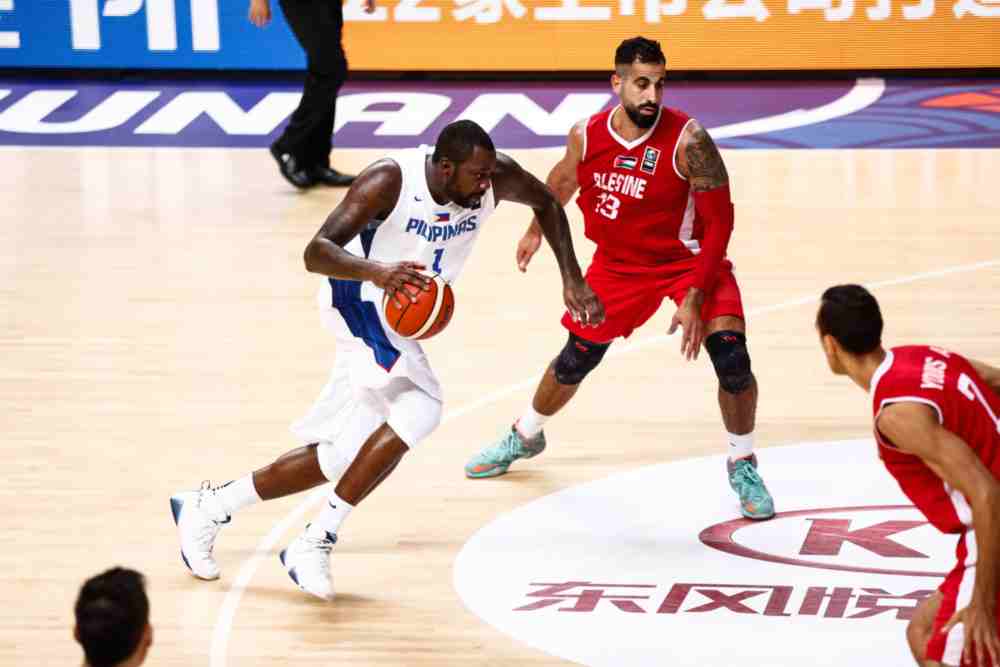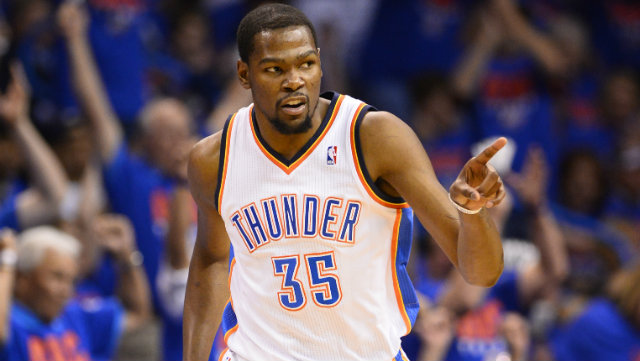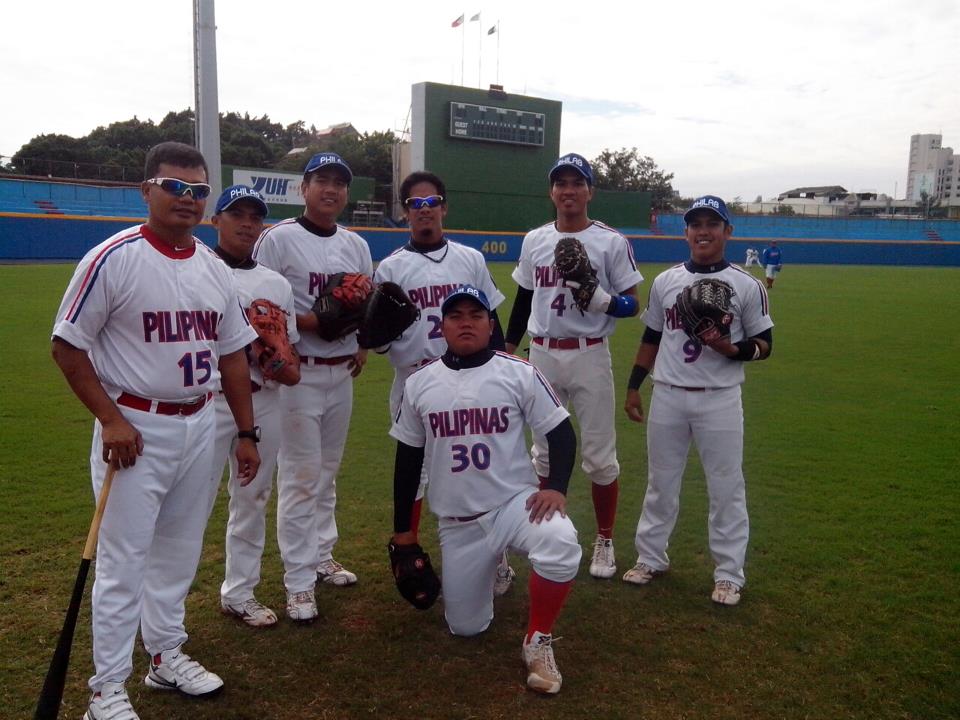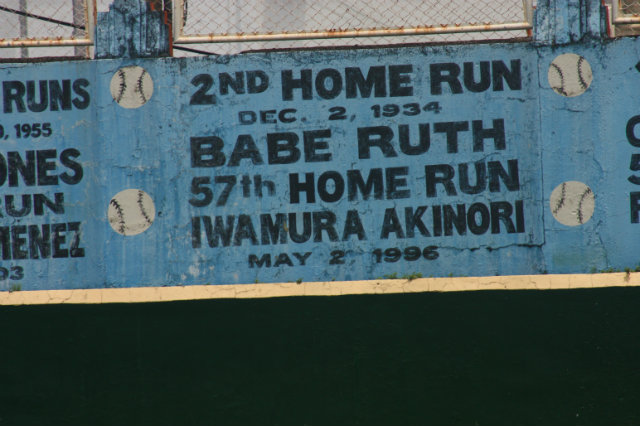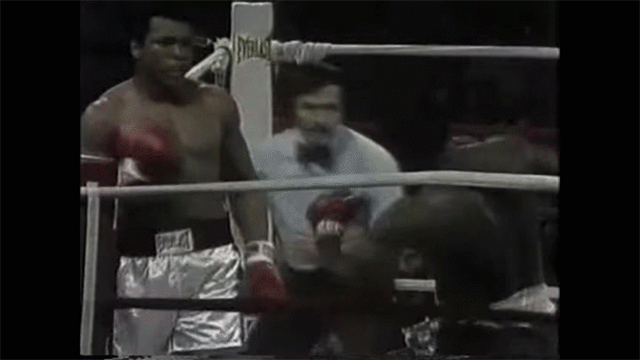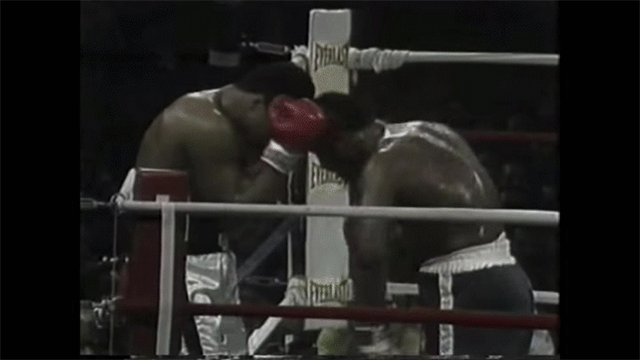![]()
If they had been in their right minds, Muhammad Ali and Joe Frazier wouldn't have faced each other for a third time.
Both had shown signs of deteriorating skills; Ali past his butterfly-floatin' self ,and Frazier, exposed after being thrown around like a doll by George Foreman’s fists in their heavyweight title fight in 1973. The popular opinion was a third bout would only shed an embarrassing light on Ali and Frazier, who were already a shell of the two men that battled for the hearts and minds of Americans in their historic first meeting in March 1971.
But that's the thing: Part Three happened because it was Ali and Frazier, a rivalry so heated and a shared history between two proud champions so deep and personal that 27 rounds weren't enough to satisfy their lust to incapacitate each other. A tiebreaker, no matter how nonsensical, needed to take place.
And so, with a blood feud providing the backdrop and Ali wasting no time spitting some rhymes to announce the bout, the “Thrilla in Manila” was penciled in for October 1, 1975.
The temperature was pegged at 32 Celsius that day, but inside the Philippine Coliseum — known today as the Araneta Coliseum — many swore the mercury rose to more than 40 C.
Ali was the two-to-one favorite, with a guaranteed purse of $4.5 million (close to $20 million today, adjusted for inflation). Frazier’s cut was $2 million ($8.8 million).
“What it came down to in Manila wasn't the heavyweight championship of the world,” Jerry Izenberg, a sportswriter for the Newark Star-Ledger told Thomas Hauser in Hauser's book, Muhammad Ali: His Life and Times.
“They were fighting for the championship of each other.”
On a hot morning in Manila, Ali and Frazier met for the last time in one of the most brutal encounters in boxing. Less a manifestation of sweet science, more a product of Dr. Frankenstein's lab, what took place was an act of perversion fueled by genuine hatred and resulting in a near-death experience, an untethered series of assaults pandering to the degenerate in all of us. Just par for the course, since this was Ali-Frazier.
What follows is a round-by-round break-down of the fight based on accounts by people who actively participated in the match or watched it.
ROUND 1
Hugh O’Brien, an American actor and guest analyst on HBO’s live coverage of the Thrilla: "Ali realizes he’s got to come out and try to do something in the first five rounds and that round proved it. He’s going at Joe. He’s not sitting back and playing around."
![]()
Ferdie Pacheco, Ali’s corner physician and author of the book, The 12 Greatest Rounds of Boxing:“Ali's intention was to knock Frazier out in the first five rounds. He almost did.”
Eddie Futch, Joe Frazier's trainer, in an interview on NBC's Saturday Sports Showcase Presents The Greatest Fights Ever:“Going into the first round, we were attempting to lure Ali into throwing the uppercut at Frazier as he had done in the first fight. Our strategy then was to step in with a left hook as he threw the uppercut, and the bobbing and weaving was done in order to make Ali throw that punch. Ali did not go for it because he remembered the first fight when he got hurt on a couple of occasions doing just that. We didn’t expect Ali to come out that fast. We really didn’t. In the previous two fights, the pace had been more normal.”
Dave Wolf, sports journalist and a veteran member of Frazier's camp:“Joe wasn't getting low enough and he was eating a lot of Ali's jabs.”
Mark Kram, Sports Illustrated journalist:“True to his plan, arrogant and contemptuous of an opponent's worth as never before, Ali opened the fight flat-footed in the center of the ring, his hands whipping out and back like the pistons of an enormous and magnificent engine. Much broader than he has ever been, the look of swift destruction defined by his every move, Ali seemed indestructible.”
ROUND 2
Mark Kram: “Frazier's legs buckled two or three times in that first round, and in the second he took more lashing as Ali loaded on him all the meanness that he could find in himself.”
Ferdie Pacheco:“He rained blows on Joe, whose ability to take a punch had been questioned since Foreman had bounced him around like a basketball a year before in Jamaica. Now, Frazier kept coming, cannonball shots caroming of his iron jaw, and then he suddenly staggered. Frazier was in trouble! Ali saw this and pursued him relentlessly. After Frazier had made it safely to the bell, Ali began to view him in a different light. This wasn't going to be easy after all.”
![]()
Fight referee Carlos Padilla: “I told (Ali) not to hold Frazier to the back of the head and at the same time pull him. That's Ali's habit during fights. He was little bit surprised. He looked at me, ‘Who is this guy holding me at the back of my head and warning me?’”
ROUND 3
Thomas Hauser, an American author, who wrote the Ali biography, Muhammad Ali: His Life and Times:“Great fights between great fighters are few and far between. In the early rounds, Ali was dominant. He was moving, jabbing. Joe couldn't get to him. In the first few rounds you said, "OK, Ali's going to win this fight."
Angelo Dundee, Muhammad Ali’s trainer, from his book, A View From My Corner: “In the third, Ali caught Frazier with two lead lefts, jerking Frazier's head back. But Frazier, an Energizer Bunny in boxing trunks, kept coming forward, forcing Ali into the ropes where Ali grabbed his shorter foe, pushing his head down.”
![]()
Ken Norton, a guest analyst on the HBO crew and one of only two men besides Frazier to beat Ali prior to the Thrilla:“Joe’s trying to pick his spots, he’s trying to get between the hands, trying to go behind the elbow and in the kidneys, which is bound to have a telling effect if the fight goes that far.”
Don Dunphy, a boxing broadcaster who was the anchorman who led the four-man HBO broadcast panel:“I noticed that Ali missed a lot in that round as though he was overanxious.”
ROUND 4
Flip Wilson, an American actor and TV host, who was a guest analyst on the HBO crew:“I think Joe is starting to smoke.
Jerry Izenberg:“In the fourth or fifth round, somewhere in there, Joe hits him with a right hand. I didn't think Joe could tie his shoes with his right hand. And Ali pulls back and he says, ‘You have no right hand. You can't do that. You can't do that.’ Bing. He hits him with another right hand. Suddenly, Ali had to think there were two hands in this fight on the other side. That was important.”
Angelo Dundee: “All of a sudden the man Muhammad had thoroughly discounted was now so alive his breath could cloud a mirror, and Ali couldn't believe it. At the bell ending the fourth, all he could do was sniff at Joe, ‘You dumb chump, you!’”
ROUND 5
Don Dunphy:“I’d have to say that this is an awful like the first fight between Frazier and Ali in 1971, when Ali built up a big lead and then Frazier started to come on. I thought Frazier came on there.”
Ken Norton:“Very good left hook there by Joe. This is going to be very detrimental to Ali in the later rounds if he stays in the ropes.”
![]()
Angelo Dundee: “The fifth was Frazier, Frazier and more Frazier . . . My screams became shriller and more insistent: ‘Get off the goddamn ropes. Get out of the goddamn corner. Stop playing!’”
Eddie Futch:“I wanted him to pressure Ali and back him against the ropes so he could get off those good, solid body shots with the hopes of bringing Ali's hands down for the shots to the head. Most of the fellas, when they fought Ali, they would back him to the ropes then go immediately to the head with the left hook. (Ali) would just pull back, stretch the rope, make the puncher miss and you're off balance then he'll hit you with a thousand punches.”
ROUND 6
Ed Schuyler, a sportswriter for the Associated Press, in a interview that appeared on Muhammad Ali: His Life and Times: “Frazier hit Ali with a left hook that’s the hardest punch I’ve ever seen. It had to be harder than the punch he knocked Ali down with in their first fight. Ali’s head turned like it was on a swivel, and his response was to look at Frazier and say, ‘They told me Joe Frazier was washed up.’ And Frazier answered, ‘They lied.’”
![]()
Jerry Izenberg: “They were tremendous hooks. And you have to understand, normal fighters would not have continued. I mean, this fight could have been over six times.”
Mark Kram:“Once more the pattern emerged as Frazier loosed all of the fury, all that has made him a brilliant heavyweight. He was in close now, fighting off Ali's chest, the place where he has to be. His old calling card — that sudden evil, his left hook — was working the head of Ali.”
Ferdie Pacheco:“By the end of this round, Joe Frazier wasn't only fighting with strength, but he was fighting with joy. It's as if he understood that the title was his for the taking, that Ali was getting tired and he was getting stronger.”
Angelo Dundee:“By the sixth any and all thoughts of an easy victory for Ali had vanished as Frazier attached himself to Muhammad's chest and let fly with several left hooks from hell, catching Ali with two that caused the crowd to gasp, President Marcos to wince and Imelda Marcos to stare down at her shoes.”
ROUND 7
Ken Norton:“At the present time, I would have to say that Frazier is in better condition.”
Dave Wolf from Muhammad Ali: His Life and Times: “By the seventh round, neither man had any mobility left at all. They were just standing there, pounding on each other. And there was frustration in watching it, because part of the strategy Eddie Futch had worked on with Joe was to batter Ali’s arms. We knew Ali would do the rope-a-dope, and it would be hard to come up the middle against him at first. But if you beat the crap out of his arms, a space would open up; and Joe didn’t do that enough . . . I think it came down to this emotional thing, where he was fighting with so much hatred that it was almost as though he couldn’t be bothered to go after the arms. He wanted Ali’s head.”
ROUND 8
Don Dunphy, in the “Thrilla” documentary: “Hugh, the '71 fight was a super fight, but I think this is just as super.”
Hugh O’Brien: “Actually, I think it’s better. Ali’s really staying in there and punching with him all the way. You couldn’t say either one is carrying the fight to the other at this point I don’t think. And I think they’re both in superb condition. And Frazier is unbelievable. The amount of times that he got hit in the head, he got caught there, he could stand there and he could keep coming at him. He’s fantastic.”
![]()
Eddie Futch: “I wasn't too concerned about those shots because the shots never had the full body of Ali into him. Joe has the faculty of making his opponent hurry everything that he did. Consequently, although Ali was rather landing him frequently there, he didn't have the full power had he had more time.”
ROUND 9
Don Dunphy: “I give that round to Frazier on aggressiveness.”
Ken Norton:“Power and aggressiveness. Plus when Ali starts to box, he dances for maybe a few seconds and he always ends up with his back on the ropes, which is very bad. This is Joe’s best place. If Ali stays on the ropes, he’s going to be picked to death by Joe’s punching power. And that’s why Ali needs to keep him in the centre of the ring. Or he has to put Frazier on the ropes and get off the ropes quick. If (Ali) stays on the ropes, he’s definitely going to fall behind. Joe’s best position is on the ropes. He can’t match Ali for speed in the middle of the ring. He can’t do anything in the middle of the ring. He’s too short.”
Don Dunphy: I would think that (Frazier’s) body shots have got to take some toll on Ali, but Ali’s a remarkable athlete. Up to now, they don’t seem to have bothered him.
Ken Norton:“They have to bother him. He hasn’t been dancing. He starts to dance and he comes off his toes, which means the body shots are bothering him.”
Eddie Futch:“I thought our battle plan was being put into play. I figured that the fact that Frazier was able to get to Ali in the latter part of every round would wear Ali down eventually and perhaps we could come on to winning the last few rounds.”
Freddie Pacheco, from the NBC special:“Frazier begins to understand that his chances of a championship are diminishing as the punishment and damage to his face increases.”
ROUND 10
Ferdie Pacheco: “Ali thought he was dying. In the 10th round, he said, ‘I think this is what dying is like." I said, 'You're not dying. We got a long ways to go before we get to dying.’ Like after the 15th round, you can die. But up to that point, you gotta keep on fighting.”
![Muhammad Ali's face during the tenth round shows the damage he had incurred. Screenshot from YouTube]()
Angelo Dundee:“I said, well, we gotta separate the men from the boys. What the heck. The shots they were nailing each other then. Battle of attrition. Wanted it more. It was all there.”
Flip Wilson: “It’s definitely turned out to be the Thrilla that everyone expected. I think we’re in for a few more rounds. I was awful in my prediction of it ending before nine.”
ROUND 11
Don Dunphy: “I’ve seen a lot of them, but this has got to rank with Louis and Conn, Marciano and Walcott and the first Ali-Frazier fight. This is one of the great ones.”
Ken Norton:“That’s very true. These men aren’t staying on the ropes. This is when men become men. There’s no playing on the ropes. Ali’s fighting back. He’s fighting more than people thought he could on the inside. There’s a lot of action here.”
Ed Schuyler, as quoted in the Thrilla documentary:“After four rounds, I thought it was 2-1-1 for Ali. But from the fifth round through the 11th, I only gave Ali one round.”
ROUND 12
Don Dunphy: “I thought Joe Frazier showed signs of tiring for the first time in that round. He had Ali on the ropes a couple of times and he didn’t seem to have any zip. Now that’s just my opinion.”
Ken Norton: “I think he was told from his corner by Eddie Futch, that he’s been throwing a lot of power shots to the body . . . I would have to say that Eddie had told the man like get him on the ropes, throw the punches, don't put as much power into them, just get the points behind them.”
Angelo Dundee:“Somehow, someway, somewhere with both gladiators running on empty, Muhammad found that something extra in his gas tank in the twelfth after I had exhorted him to ‘go get him.’ Using his long right, he reversed the by now all-too-evident flow of the fight by getting back on his toes and pummeling Frazier's face, turning it into a mass of lumps, bringing a trickle of blood from his mouth and closing his left eye. It was unbelievable! Here was Muhammad, who in the eleventh round looked like he could have tossed it in, sucking it up and dominating Frazier.”
Eddie Futch: “I was concerned about the swelling in the left eye because it was quite pronounced at this time. I was afraid that Joe was going to have a lot of trouble seeing those right hands coming and it turned out to be the case.”
Joe Frazier's cornerman, George Benton: “What I would've done, I would've told Eddie, ‘Look Ed, let's just make (Frazier) jump up and down in the corner and throw punches up in the air like he was trying to kill (Ali).’ And Ali seeing this and seeing Joe full of venom, he would've probably quit in the corner seeing Joe had so much left. But we really didn't know. I heard Ali say, ‘I’m not going back out there, this man's crazy.’ But we didn't take advantage of it, because neither one of us felt that Joe could go on with his bad eye. But now looking back, that's what I would've done.”
ROUND 13
Ken Norton: “Ali seems to coast until he sees an opening. When he has that opening, he throws a big, rapid flurry. This has been Joe's downfall. Joe cannot match hand speed with him, so when Ali throws a quick flurry at him, he's very vulnerable. Very vulnerable.”
Eddie Futch: “The 13th round was very bad, but I thought maybe Ali had punched himself out and would be arm-weary after landing so many good blows. That’s the reason I let Joe go out for the fourteenth, and it was worse than the round before.”
George Benton: “Like I said before, if we had made Joe bounce up and down, that would've gotten (Ali) to quit. But in all reality, Joe had one eye in that round. If he doesn't get knocked out, there's no way he could knock Ali out coz he didn't have any power. There was nothing there. Nothing but slaps. Neither one of them had anything left, but the thing Ali had going for him was that each time he poked Joe in the eye, the lightest punch, it could hurt him because his eyes were already swollen.”
ROUND 14
Ferdie Pacheco, from the Thrilla in Manila documentary:“Round 14 was the closest thing I've seen somebody kill somebody. He was very close to killing him.”
Joe Frazier, recalling his mindset in the moment in The Thrilla in Manila documentary:“No, man. Let me continue. I don't want to stop. Let's keep on going. C'mon, Ed.”
![]()
Eddie Futch: “I saw that Joe wasn't able to see the punches coming, especially the right hand. He was getting hit by punches that he didn't see at all. So I didn't want to take a chance at him being permanently injured or probably fatally injured. So I stopped the fight.
Frazier would have continued. In fact, he resisted slightly when I told him the fight was over. He had been sitting on the stool and he jumped up and I just put my hand on his shoulder and pressed gently and he sat down again. He'll be relying on my judgment.”
Thomas Hauser: “Wali Muhammad, who was a cornerman for Ali, told something that I hadn't heard before and found extraordinary but Ali later confirmed for me, which is Ali went back to his corner and said to Angelo, ‘Cut 'em off.’”
Wali Muhammad, from Muhammad Ali: His Life and Times: "After the fourteenth round, Ali came back to the corner and told us, ‘Cut 'em off.’ That's how tired he was. He wanted us to cut his gloves off. And Angelo ignored him. He started wiping Ali's face, getting him ready for the fifteenth round . . . Ali's not a quitter; he'd never quit. But I'd never seen him exhausted like that before. Then somebody — I think it was Kilroy (Gene Kilroy, coordinator for Ali’s camp)— looked across the ring and saw Eddie Futch call the ref over. Kilroy started shouting, "It's over! It's over!" And the feeling I had then; I can't express it. In the dressing room afterward, Bundini (Drew “Bundini" Brown, Ali’s cornerman) and me, we just broke down and cried.’”
Dave Wolf:“I believe that Ali was significantly more exhausted and had been beaten so much to the body that there was a real chance that if Eddie Futch had not stopped the fight in the corner after the 14th round that Ali wouldn't have come out for the 15th round and that Joe would've won. I know that's what Joe believed at that time.”
EPILOGUE
Futch’s decision would gnaw at Frazier for a long time. In Kram’s book, Ghosts of Manila, Frazier at one point brushed aside Futch’s reasoning that he was only trying to save his life, even attacking his trainer’s judgment many years after the fight.
Frazier told Kram that Futch had been “too soft to have been in charge” and that Yank Durham, Frazier’s manager right before Futch, would have sent him out for the 15th round in Manila. Futch said he never regretted making the call because he had witnessed boxers die in the ring.
In Manila, Ali emerged the victor, but in Frazier's mind he won the war. In several instances years later, Frazier relished the thought that he was responsible for Ali's current debilitating condition. He had gone on record to say he no longer harbored any ill will, but there had been interviews of Frazier in which it was evident some animosity still festered.
Freddie Roach, who had trained under Futch, knew how embittered Frazier was. “I know he was mad at Eddie for a long time after that,” Roach said. “It took a little time for him to get over it.”
Futch died on Oct. 10, 2001. Frazier fought twice more after Manila before hanging up his gloves. He died on Nov. 7, 2011.
Immediately after Ali was declared the winner, he collapsed on the mat because of utter exhaustion. He would soften his tone on Frazier, apologizing on a number of occasions for the times he had insulted him and acknowledging that it was all promotional not personal.
Ali fought 10 more times after the Thrilla, a stretch that included claiming the world heavyweight title for a third time following his victory over Leon Spinks in September 1978. In 1984, Ali was diagnosed with Parkinson’s disease.
It took a long while before Ali and Frazier watched the Thrilla in Manila.
Frazier hadn’t seen it until he was convinced to do it for the Thrilla in Manila documentary in 2009. For Ali’s part, Hauser, in a story he wrote recently for The Ring magazine, said that “despite the fact that it was one of his greatest ring triumphs, there was no joy in Muhammad’s face as we watched Ai-Frazier III unfold.”
Ali, now 73, attended Frazier’s funeral in November 2011.
“Joe Frazier is a good man,” Ali told Hauser in his book. “I couldn’t have done what I did without him, and he couldn’t have done what he did without me. And if God ever calls me to a holy war, I want Joe Frazier fighting beside me.”
Sources:
· George Benton’s quotes were from an interview for the TV special NBC's Saturday Sports Showcase Presents The Greatest Fights Ever.
· Angelo Dundee’s quotes were excerpted from his book, A View From My Corner, unless otherwise stated.
· Eddie Futch’s quotes were from an interview shown on the NBC Greatest Fights Ever special, unless otherwise stated.
· Mark Kram’s quotes were excerpted from his Sports Illustrated article titled, "Lawdy, Lawdy, He's Great.”
· Ferdie Pacheco’s quotes were from an interview shown on the NBC Greatest Fights Ever special and the Thrilla in Manila documentary.
· Carlos Padilla’s quotes were from an interview shown on the NBC Greatest Fights Ever special.
– Rappler.com
![]()

